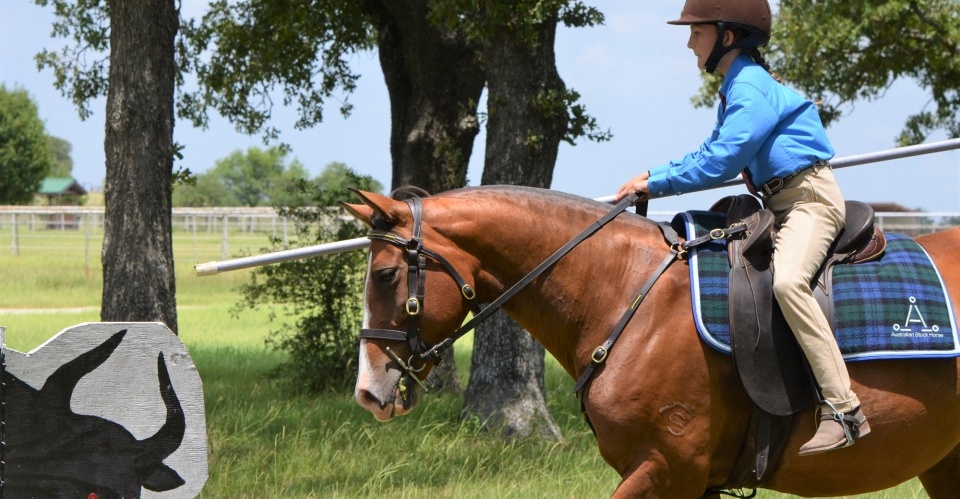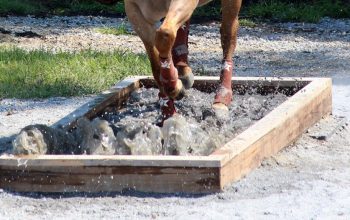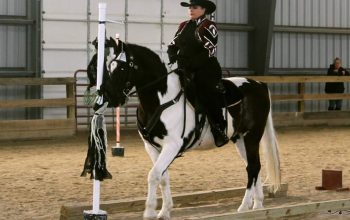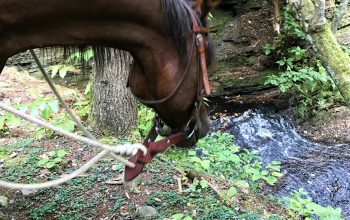The obstacles used in Working Equitation’s Ease of Handling and Speed trials are intended to simulate those a horse/rider might encounter when working on the ranch. The connection is perhaps most obvious with the Bridge obstacle and perhaps least intuitive (for North American riders, anyway) in the obstacle collectively referred to as Retrieve a Pole/Skewer a Ring/Place a Pole.
For Working Equitation, the bridge should be solidly constructed of wood, with a non-slippery deck. A Working Equitation bridge may be arched or angled in its rise. The bridge should be at least five feet wide, thirteen feet long, and rising to a minimum height of eight inches. The bridge may have side rails between three and four feet in height. If side rails are used, for safety considerations the rails must be constructed such that they can be quickly and easily removed without the use of tools.


In Working Equitation competitions, the bridge must be crossed at a walk in the Ease of Handling trial and may be crossed at any gait in the Speed trial. As they are deciding on a score from 0 – 10 to award for the obstacle, Judges evaluate the transition to the trot as riders approach the bridge, the quality and regularity of the walk and the straightness of the horse going over the bridge, and the confidence of horse and rider while they are navigating the obstacle. Judges deduct points if the horse shows awkwardness, hesitation, or irregularity.
Unlike some other sports where your score might be enhanced if the horse lowers its head when approaching or crossing the bridge, in Working Equitation, the horse is expected to maintain the same frame while approaching, crossing, and departing from this obstacle.
The reason for this difference can be traced back to the roots of the sport in Southern European countries that pride themselves on producing fighting bulls. When working with aggressive cattle, it is important that the horse always be “at the ready” in case the rider needs to ask for a rapid depart. Thus, in Working Equitation, horses are generally rewarded for working from their haunches and maintaining lightness on the forehand.
The historic base of the sport is also celebrated through the use of a garrocha, or long pole used to work cattle in Spain and Portugal (one generally wants to keep fighting cattle away from one’s horse rather than using a rope and drawing them in). In most Working Equitation competitions, you will see riders ride up to an open-top barrel, pick up an 8-11 ½ foot pole, skewer a ring (often attached to a cut-out of a bull), and then ride to another barrel in which they deposit the pole (with the ring if they were fortunate enough to skewer it).

This particular obstacle can be divided into as many as three separate obstacles (each worth 10 points for 30 points possible overall), or can be ridden consecutively with no obstacles in between, for a total of 10 points possible.
The rider should approach the barrel and retrieve the pole without stopping or breaking gait. The horse should advance at a steady gait and not react negatively to the appearance of the drum or the rider’s removal of the pole. The rider may circle the drum once before picking up the pole, though this is considered less difficult than a straight approach and may result in a slight reduction in score.

The Judge evaluates the cadence and confidence which the horse approaches the obstacle and the fluidity with which the rider completes the exercise. Any break in the horse’s movement with loss of fluidity or striking any part of the obstacle is penalized. Skewering the ring is not nearly as important as the style/approach to the obstacle, the continuity in movement of the horse and rider, the correct bend, correct lead, and evenness of gait. Dropping the ring after picking it up or failure to skewer the ring will result in a lower score.
The final part of the obstacle sequence occurs when the rider places the pole (with the ring if it has been skewered) into the designated barrel. Sometimes, the same barrel is used for retrieval and replacement; often, two different barrels are used.
This particular obstacle is a good test of how well the horse and rider are responding to seat and leg cues. It quickly becomes obvious whether one depends on the reins for guidance quickly when one is holding a ten-foot pole in one hand and having to maneuver around a tight course, particularly at speed.
Complete descriptions of these as well as the other 21 obstacles can be found in the United States Rules for Working Equitation, available for free download from our website.
 By Julie Alonzo
By Julie Alonzo
For more information about Working Equitation United be sure to visit their website! www.weunited.us




